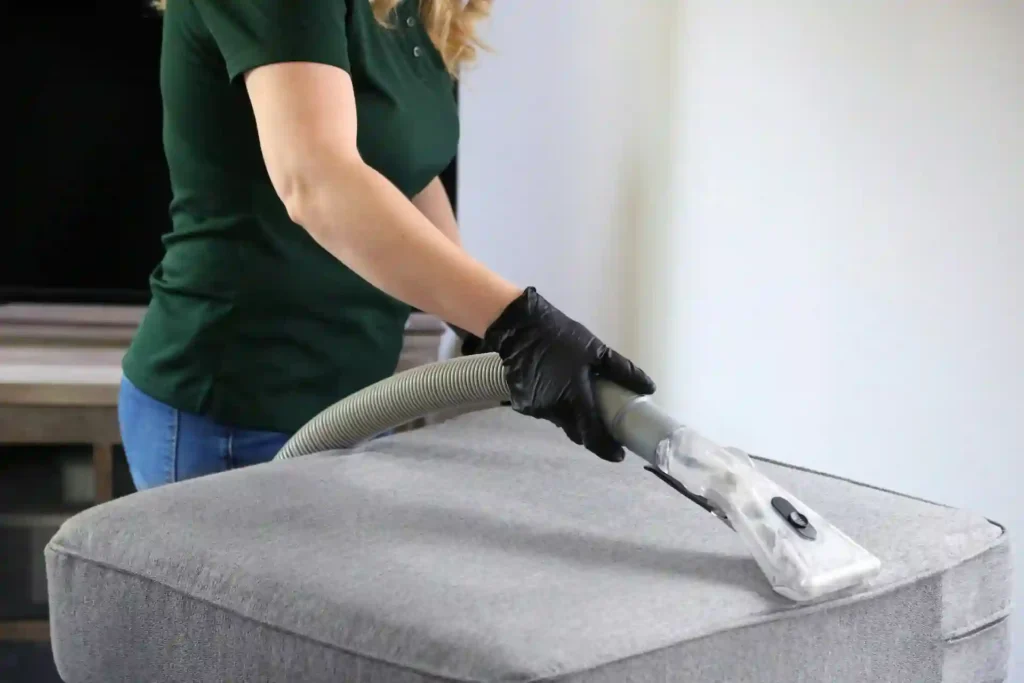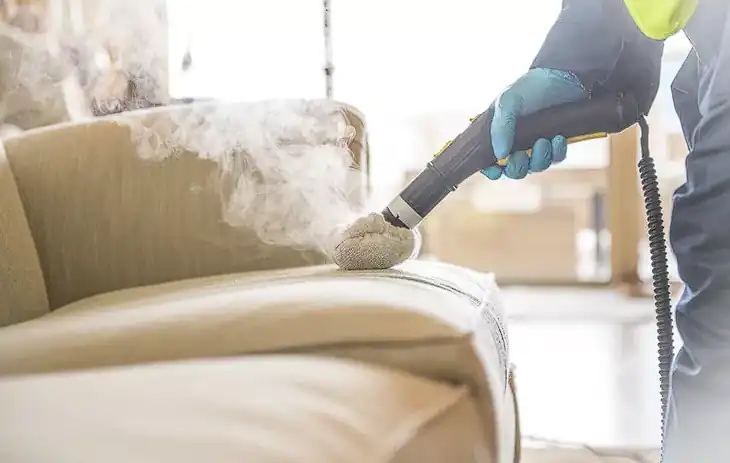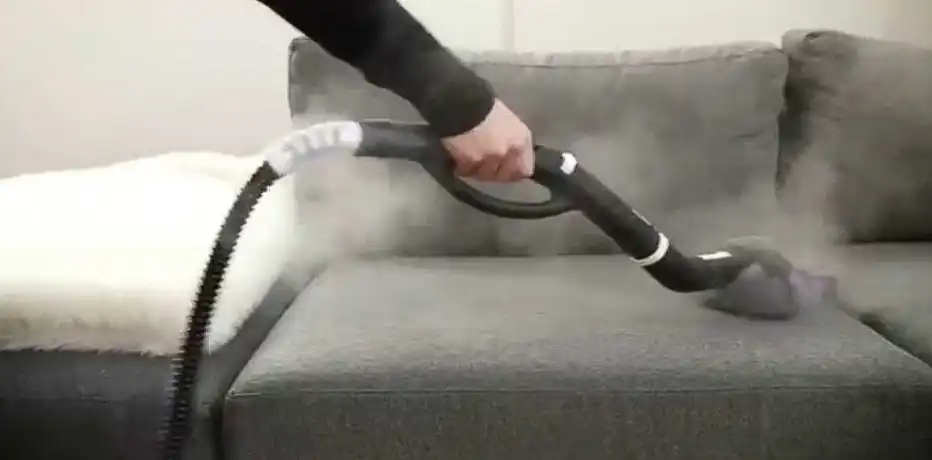How to Clean Your Couch with a Steam Cleaner: A Comprehensive Guide
Cleaning your couch might seem daunting, but trust me, it doesn’t have to be. I’ve been there, staring at those stubborn stains, wondering if my couch would ever look fresh again. But once I discovered the magic of steam cleaning, everything changed. In this resourceful guide, I’ll walk you through the steps I use to make my couch look brand new—without the hassle.
We’ve got you covered after dealing with spills, pet fur, or everyday grime. So, let’s dive in and get that couch looking as good as new!
Steam Cleaning vs. Upholstery Cleaning: What’s the Difference?
When I first started exploring how to clean my couch, I came across two terms that seemed similar but were quite different: steam cleaning and upholstery cleaning. While both aim to refresh and clean furniture, the methods and results vary significantly, especially when maintaining your couch.

Steam Cleaning: My Go-To for Deep Cleaning
THE NAME SUGGESTS | Steam cleaning uses hot steam to clean surfaces. The steam penetrates deep into the fabric, loosening dirt, grime, and stubborn stains. What I love about steam cleaning is that it doesn’t rely on harsh chemicals. Instead, the high steam temperature does most of the work, which is a huge plus since I prefer to keep my home environment as chemical-free as possible.
When I steam clean my couch, it not only looks cleaner but also feels fresher. The steam effectively kills bacteria, dust mites, and other allergens that might be lurking within the cushions. This makes it an excellent choice if you have kids, pets, or anyone in the household with allergies. Plus, steam cleaning is versatile—I can use it on a variety of fabrics without worrying about damage.
KEEP IN MIND | Steam cleaning requires some drying time. After I finish, I usually let my couch air out for a few hours to ensure it’s completely dry. This is important because if the fabric remains damp, it could lead to mildew or mold.
Upholstery Cleaning: A More Traditional Approach
Upholstery cleaning, on the other hand, typically involves a combination of vacuuming, spot cleaning, and sometimes using specialized cleaning products designed for fabric.
I ADOPTED THIS METHOD and found it particularly effective for quick touch-ups or specific stains. For example, if there’s a spill on the couch, I might use an upholstery cleaner to spot-treat the area before it sets.
One advantage of upholstery cleaning is that it usually doesn’t require as much drying time as steam cleaning. Depending on the product and method, my couch might be ready to use quickly.
However, upholstery cleaning might not be as effective for deep cleaning as steam cleaning. It’s great for maintaining the appearance of the couch and tackling surface stains, but it doesn’t penetrate as deeply as steam cleaning.

Choosing Between the Two
When it comes to choosing between steam cleaning and upholstery cleaning for your couch, it depends on what you’re trying to achieve. Steam cleaning is ideal for a thorough, deep clean that refreshes furniture. If you’re looking to maintain your couch and handle occasional stains, upholstery cleaning might be sufficient.
I prefer to use a combination of both. I’ll steam clean my couch every few months to keep it in top condition and use upholstery cleaning methods as needed for quick fixes. This way, I get the best of both worlds—deep cleaning and ongoing maintenance.
So, if you’re wondering how to clean your couch with a steam cleaner, know that it’s an excellent choice for a deep clean, but pay attention to the value of traditional upholstery cleaning methods for day-to-day care.
Step-by-Step Process for Steam Cleaning a Couch
Now that we’ve covered the basics, let’s discuss how to steam clean a couch. Whether you use a handheld steam cleaner or a larger unit, the process remains relatively the same.
1. Gather Your Supplies
To get started, you’ll need the following:
- A steam cleaner designed for upholstery (I recommend using a dedicated steam cleaner for couches rather than a general-purpose model)
- Upholstery cleaning solution (optional, depending on your steamer’s recommendations)
- Microfiber cloths
- A vacuum cleaner
- A scrub brush (optional for tough stains)
2. Prepare Your Couch
Before you steam clean your couch, it’s crucial to prepare it properly. Start by vacuuming the entire surface to remove loose dirt, pet hair, and debris.
This step ensures you’re not pushing dirt deeper into the fabric during steam cleaning.

3. Test a Small Area
Before using the steam cleaner on the entire couch, I always test it on a small, inconspicuous area. This step is crucial because certain fabrics may react poorly to steam, resulting in discoloration or damage.
Let the test spot dry completely and inspect it closely to avoid adverse effects.
4. Start Steam Cleaning
It’s time to begin once you’re confident that the fabric can handle the steam. If necessary, fill your steam cleaner with water (and cleaning solution) and let it heat up. Steam clean your couch in sections, using slow, steady strokes to ensure even coverage. I recommend starting at the top and working your way down to prevent drips from landing on already-cleaned areas.
You can use a gentle scrub brush in combination with the steam cleaner for tough stains. Just be sure to use a light touch to avoid damaging the fabric.
5. Allow the Couch to Dry
After steam cleaning the entire couch, it’s essential to let it dry completely before using it again. Depending on the fabric and the humidity level in your home, this could take anywhere from a few hours to overnight. I usually speed up drying by opening windows and turning on a fan.
The Benefits And Downsides Of Steam Cleaning A Couch
Benefits:
Deep Cleaning Power:
Let’s face it—couches endure a lot. From spilled coffee to pet hair and everything in between, they can become a breeding ground for dirt and germs. Steam cleaning tackles this head-on. The high-temperature steam penetrates deep into the fabric, killing bacteria, dust mites, and other allergens. It’s like giving your couch a spa day. Every time I steam clean, I’m amazed at how fresh and revitalized my couch feels afterward. It’s satisfying to know that I’m not just cleaning the surface but getting rid of the hidden nasties.

Chemical-Free Cleaning:
One of the biggest perks of steam cleaning is that it doesn’t rely on harsh chemicals. This is a huge win for me as someone who’s pretty particular about the products I bring into my home. The steam does all the work, meaning there are no lingering chemical residues that could be harmful to kids, pets, or even me. It’s an eco-friendly and family-friendly way to keep things clean.
Quick Drying Time:
I dreaded couch cleaning days because it meant dealing with soggy cushions and endless drying times. But steam cleaning changed the game. The minimal water used in the process means the couch dries quickly. Depending on the fabric, it could be ready to use within a few hours, not days. So, I can return to binge-watching my favorite shows on a clean couch in no time.
Downsides:
Not Suitable for All Fabrics:
Here’s where things get tricky. Not all couches are steam-cleaning-friendly. Heat and moisture can damage delicate fabrics like silk and certain types of upholstery. It’s essential to check the manufacturer’s guidelines before diving in with a steamer. I learned this the hard way with a velvet throw pillow that, let’s say, didn’t survive the process.
Risk of Over-Wetting:
Steam cleaning is powerful, but it’s easy to overdo it. Too much steam can lead to overwetting, which can cause issues like mold or mildew if the couch doesn’t dry properly. I’ve had to be really mindful of this, especially in humid weather. It’s all about finding that balance—enough steam to clean effectively but not so much that the couch stays damp.
Learning Curve:
I won’t lie—my first few attempts at steam cleaning were a bit of a mess. There’s a learning curve to getting it just right. It takes a bit of practice, from figuring out the right attachments to using the correct technique. But once I got the hang of it, it became a much more manageable task. However, hiring a professional might be better if you’re not up for trial and error.

How Often Should You Steam Clean Your Couch?
The Short Answer: It Depends
If you’re like me and enjoy a cozy night on the couch with some popcorn and Netflix, giving your couch a thorough steam cleaning every 3 to 6 months should do the trick.
Pets and Kids: The Game Changers
I’ve got a dog who thinks the couch is his playground, so I know firsthand how quickly things can get messy. If you’re in the same boat, you’ll want to steam clean more often. With kids, it’s the spills, crumbs, and sticky fingers. Trust me, a quick steam clean can be a lifesaver.
Allergy Sufferers, Take Note
Regular steam cleaning is a must if anyone in your household has allergies. Dust mites, pollen, and other allergens love to hide in the fibers of your couch, and vacuuming alone won’t cut it. I’d recommend steam cleaning every 2 to 3 months to keep those allergens at bay and your home’s air quality in check.
The Lazy Factor: When “Spot Cleaning” Isn’t Enough
I get it—sometimes life gets busy, and deep cleaning your couch falls to the bottom of the list. But here’s the thing: spot cleaning can only do so much. Sure, it might tackle that wine spill or muddy paw print, but dirt and grime build up over time. Trust me, when you get around to a full-steam clean, you’ll be amazed (and maybe slightly disgusted) by what comes out.
Maintaining Upholstery Cleanliness
To keep your couch looking its best between steam cleanings, there are a few simple maintenance tips I follow:
- Vacuum Regularly: Regular vacuuming helps prevent dirt from settling into the fabric.
- Spot Clean Spills Immediately: The sooner you address spills, the less likely they are to leave a stain.
- Use a Fabric Protector: Consider applying a fabric protector after steam cleaning to repel future stains.
Can You Steam Clean a Couch with Down Cushions?
You can steam clean a couch with down cushions, but it requires extra care and attention. I’ve done it myself, and while it’s effective, there are a few things to remember. Down cushions are delicate, so it’s important not to oversaturate them with steam. Too much moisture can cause the down to clump together, leaving your cushions lumpy and uncomfortable. I always start by using a low steam setting and keeping the steamer moving, always lingering for a while in one spot.
One thing I learned the hard way is that after steam cleaning, you must give those down cushions plenty of time to dry. Down is notorious for trapping moisture; the last thing you want is a musty smell or mold. I like to prop the cushions up in a well-ventilated area, sometimes even using a fan to speed up the drying process. Trust me, it’s worth the extra effort to keep your couch looking and feeling great without risking any damage.

FAQs on Steam Cleaning Your Couch
What are the potential risks of steam cleaning for certain fabric types, and how can these risks be mitigated?
Steam cleaning can be a fantastic way to freshen up your couch, but not all fabrics play nice with heat and moisture. Delicate materials like silk or velvet might not appreciate the intense steam, leading to potential damage or discoloration. To avoid mishaps, I always recommend checking the manufacturer’s care label first—don’t skip this step! If unsure, do a quick spot test on an inconspicuous area. And if the fabric seems too delicate, it might be best to steer clear of steam or call in a professional.
How can steam cleaning help eliminate allergens from couches effectively?
Steam cleaning is your secret weapon if you’re like me and sensitive to dust or pet dander. The high steam temperature kills dust mites, mold, and other allergens lurking in your couch’s fibers. It’s not just about surface cleaning—the steam penetrates deep, pulling out what you can’t see. Plus, there’s something deeply satisfying about knowing you’re tackling those invisible allergens head-on. For the best results, make sure you’re using a quality steam cleaner and take your time to cover every inch of the couch.
How can steam cleaning contribute to maintaining a chemical-free home environment?
I’m all about reducing chemicals in my home; steam cleaning is a major part of that strategy. Unlike some cleaning methods that rely on harsh chemicals, steam cleaning uses nothing but water. The high temperature of the steam naturally disinfects and sanitizes your couch, meaning you don’t have to worry about lingering toxic residues. It’s a win-win for both your health and the environment. Trust me, it takes time to return to those chemical-laden cleaners once you make the switch.
In what ways does steam cleaning provide a thorough and deep clean for couches?
Steam cleaning doesn’t just give your couch a quick surface wipe—it goes much deeper. The heat and moisture work together to break down grime, stains, and dirt embedded in the fabric. It’s like giving your couch a deep, detoxifying spa treatment. When I steam clean my couch, I can immediately see and feel the difference. The fabric feels fresher, smells cleaner, and looks rejuvenated. It’s one of those things that’s worth the effort for the deep clean you just can’t get with regular vacuuming.
What are the best practices for preparing a couch before steam cleaning?
Before diving into steam cleaning, it’s crucial to prep your couch properly. I always start by vacuuming the entire couch, including under the cushions, nooks, and crannies. This removes loose dirt and debris that could get stuck in the fabric during steam cleaning. Next, I’ll check the care label to ensure the fabric can handle the heat, and then I do a quick spot test in an inconspicuous area. Finally, if there are any stubborn stains, I’ll treat them with a little pre-cleaning solution or even just a bit of steam to loosen things up. Trust me, a little prep goes a long way in ensuring your steam cleaning session is as effective as possible.
Final Thoughts on Steam Cleaning Your Couch
In wrapping up, I’ve found that steam cleaning my couch seems daunting until you do it. The results speak for themselves: a refreshed, clean couch that feels almost brand new. However, I’d be lying if I said it doesn’t require some effort. From prepping the area to patiently working through each cushion and aperture, it’s a commitment.
But isn’t a little elbow grease worth it to extend the life of your furniture and maintain a healthier home environment? If you’re still on the fence, I’d say give it a shot—there’s something oddly satisfying about seeing the grime lift away. Remember, it’s not a magic wand, but it does come close.
